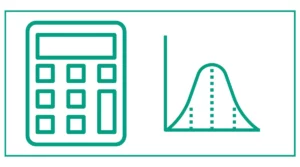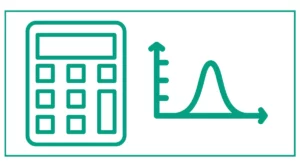Class Width Calculator
The class width calculator helps you calculate the difference between the upper and lower class limit of a class interval.
Enter the minim, maximum, and number of classes the calculate the class width.
In the event that you are unfamiliar, the size or width of a class interval is determined by the variance between the upper and lower class boundaries. It is commonly known as the class width, class size, or class strength.
Class width = (max-min) / n
- max= the upper limit
- min= lower limit
- n= number of classes

You might be interested in finding the class rank or stem leaf graph.
What is Class Width?
Class width, also known as class interval, is a key component in the creation of frequency distribution tables. It refers to the difference between the upper and lower boundaries of any class or category within a dataset. In simpler terms, class width determines the size of each class in a grouped frequency distribution.
To better understand this concept, let’s consider an example:
Imagine you’re an instructor collecting test scores for a class of 20 students. The scores range from 65 to 98. To organize this data effectively, you decide to group the scores into classes. The class width you choose will determine how these scores are distributed across different categories.
The Importance of Class Width in Data Analysis
Class width plays a crucial role in statistical analysis for several reasons:
- Data Organization: It helps in structuring large datasets into manageable groups, making it easier to analyze and interpret the information.
- Visualization: Proper class width selection aids in creating clear and meaningful visual representations of data, such as histograms and bar charts.
- Pattern Identification: By grouping data into classes, it becomes easier to identify patterns, trends, and outliers within the dataset.
- Comparison: Class width allows for effective comparison between different datasets or subgroups within a larger population.
How to Calculate Class Width
The process of calculating class width involves a simple formula:
Class Width = (Maximum Value – Minimum Value) / Number of Classes
Let’s break this down using our previous example of test scores:
- Identify the range: 98 (maximum) – 65 (minimum) = 33
- Decide on the number of classes: Let’s say we want 5 classes
- Apply the formula: 33 / 5 = 6.6
In this case, we would round the class width to 7 to ensure whole number boundaries for our classes.
Using a Class Width Calculator
While manual calculations are straightforward for simple datasets, a class width calculator can significantly streamline the process, especially when dealing with large or complex datasets. Here’s how to use a typical class width calculator:
- Input the minimum value of your dataset
- Enter the maximum value
- Specify the desired number of classes
- Click the “Calculate” button
The calculator will then determine the optimal class width for your data.
Creating a Frequency Distribution Table
Once you’ve determined the class width, the next step is to create a frequency distribution table. Here’s how you can do this using our test score example:
- Set up your classes:
65-71, 72-78, 79-85, 86-92, 93-99 - Count the frequency of scores in each class
- Record these frequencies in your table
Your frequency distribution table might look something like this:
| Class Interval | Frequency |
|---|---|
| 65-71 | 3 |
| 72-78 | 5 |
| 79-85 | 6 |
| 86-92 | 4 |
| 93-99 | 2 |
This table now provides a clear overview of how the test scores are distributed across different ranges.
Considerations When Determining Class Width
While the class width calculator provides a mathematically sound result, there are several factors to consider when finalizing your class width:
- Number of Classes: The number of classes you choose can significantly impact the effectiveness of your frequency distribution. Too few classes may oversimplify your data, while too many can make it difficult to identify patterns.
- Round Numbers: For ease of interpretation, it’s often beneficial to round class widths to whole numbers or easily divisible numbers.
- Data Distribution: Consider the nature of your data. If there are known important thresholds or natural groupings, you may want to adjust your class width accordingly.
- Purpose of Analysis: The intended use of your frequency distribution should guide your class width selection. Different purposes may require different levels of detail.
Applications of Class Width in Various Fields
The concept of class width and its calculation extends beyond academic statistics. It finds applications in various real-world scenarios:
Market Research
In market research, class width calculations can help categorize consumer data. For instance, when analyzing customer spending habits, researchers might use class width to group purchase amounts into meaningful categories.
Environmental Studies
Environmental scientists often use class width calculations when analyzing data such as temperature ranges, pollution levels, or species populations. This helps in identifying trends and patterns over time or across different regions.
Quality Control
In manufacturing, quality control processes frequently employ class width calculations to categorize product measurements. This aids in identifying whether products fall within acceptable ranges and in spotting potential issues in the production process.
The Freight Class Calculator: A Specialized Application
While we’ve primarily focused on the statistical applications of class width, it’s worth noting that the term “class calculator” is also used in other contexts. One such application is the freight class calculator, which is used in the shipping and logistics industry.
The freight class calculator helps determine the classification of goods for shipping purposes. This classification is based on several factors including density, stowability, handling, and liability. While this calculator doesn’t directly relate to the statistical concept of class width, it’s an interesting example of how classification systems are used in various industries.
To use a freight class calculator:
- Input the weight of your shipment
- Enter the dimensions (length, width, height)
- Specify any special handling requirements
- The calculator will determine the freight class based on these parameters
Understanding freight classes can help businesses estimate shipping costs more accurately and choose the most cost-effective shipping methods for their goods.
Common Questions
How do I know if I’ve chosen the right class width?
A good class width should result in a distribution that clearly shows the shape of your data without oversimplifying or overcomplicating it. If you’re unsure, try a few different class widths and see which provides the most meaningful representation of your data.
Can I use decimal numbers for class width?
While it’s mathematically possible to use decimal numbers for class width, it’s generally more practical to round to whole numbers for ease of interpretation.
What if my calculated class width results in an odd number of classes?
If your calculated class width results in an odd number of classes, you can adjust by slightly increasing or decreasing the class width, or by adjusting the number of classes.
How does class width relate to the concept of bins in data visualization?
Class width and bins are closely related concepts. In data visualization, particularly in histograms, each “bin” represents a class, and the width of each bin corresponds to the class width.

References
- Agarwal, B. L. (2006). Basic statistics. New Age International.
- Brase, C. H., & Brase, C. P. (2023). Understanding basic statistics. Cengage learning.
- Class Width – an overview | ScienceDirect Topics. (n.d.). Class Width – an Overview | ScienceDirect Topics. doi.org/10.1016/B978-0-12-802967-1.00008-5
- Tsokos, C., & Wooten, R. (2016). Basic Statistics. The Joy of Finite Mathematics, 265–327. doi.org/10.1016/b978-0-12-802967-1.00008-5





